Madison Logic is an enterprise-grade account-based marketing platform which promises to focus your firepower on high-value targets.
But in practice, many such ABM tools come loaded with features, hefty price tags, and a steep learning curve.
In this article, I’ll show you all that Madison Logic offers, its reviews, help you decide if it’s actually the right fit for your ABM strategy, and discuss where a lean alternative like ZenABM might make more sense, or may even serve as a complementary layer due to its unique features.
Let’s get started!

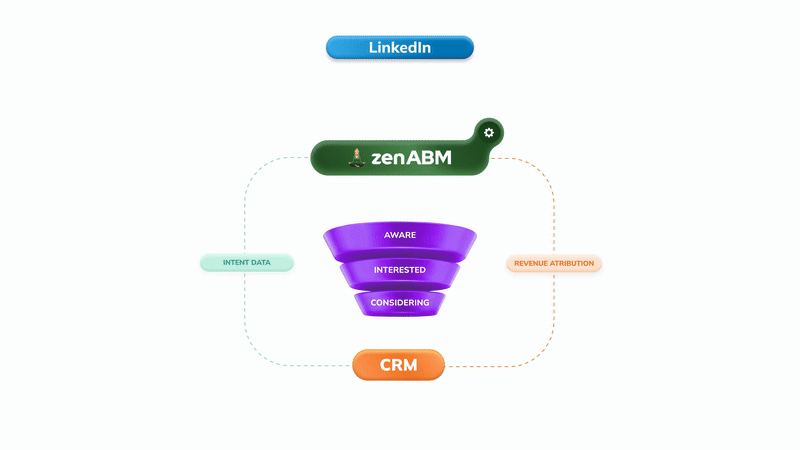
Madison Logic for ABM: Quick Summary
In case you want it short:
- Madison Logic is a full-scale enterprise ABM platform offering content syndication, multi-channel advertising (including display, LinkedIn, CTV, and audio), deep third-party intent data, and cross-platform attribution.
- Its biggest strength is intent data and scale: over 45M accounts and 417M contacts, layered with 20+ years of B2B behavior insights. Strong integrations exist with Salesforce, HubSpot, LinkedIn, and others.
- Core features include ML Insights for account scoring, ABM content syndication, real-time analytics, and targeting across firmographic/technographic dimensions.
- Challenges include complex UI, steep learning curve, reliance on third-party data (which can surface early-stage or mismatched leads), and high pricing (starting ~$3,000/mo + media).
- Alternative Worth Considering: ZenABM offers account-level LinkedIn ad engagement tracking, ad engagement-to-pipeline analytics with plusg-and-play dashboards, account scoring, ABM stage tracking, CRM sync, first-party qualitative intent, automated assignment of BDRs to hot accounts, custom webhooks, and ad engagement tracking at the job-title level. All this starts at just $59/month!
Key Features of Madison Logic
Madison Logic’s Activate ABM™ platform bundles together multiple channels and tactics under one roof.
Key features include:
Multi-Channel Advertising
Madison Logic unifies content syndication (rare feature), display advertising, LinkedIn ads, connected TV (CTV), and audio advertising into a centralized platform.
This means you can engage your target accounts with content and ads on every possible channel, from webinar whitepapers to LinkedIn Sponsored Posts to streaming TV commercials.
Intent Data & Account Prioritization
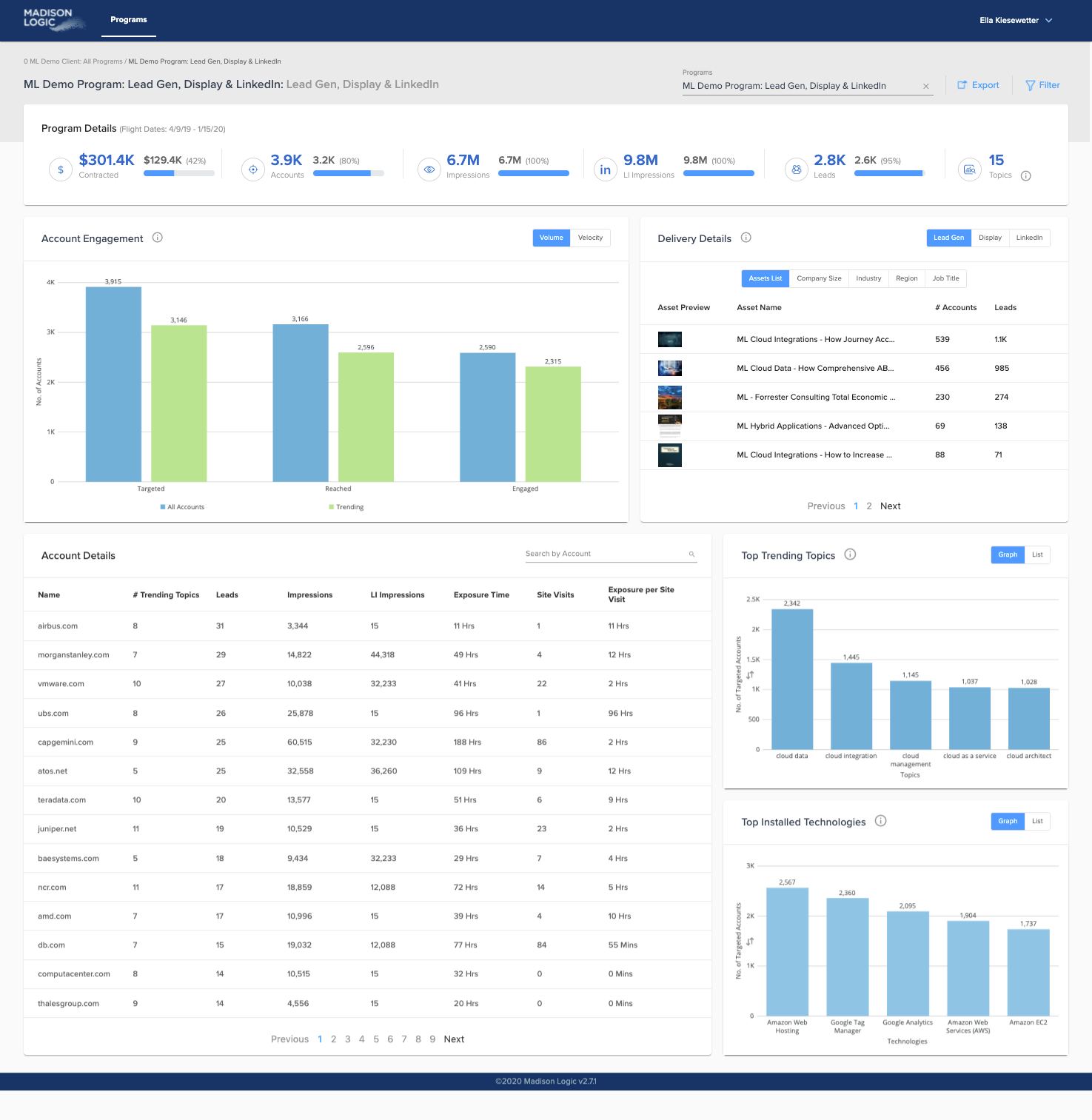

A big selling point is Madison Logic’s data.
The company boasts 20+ years of B2B intent signals, combining multiple sources and proprietary engagement data to predict when accounts are “in-market.
They tout eye-popping scale: 45 million accounts and 417 million professional contacts across 129 industries in their database.
This data feeds an AI-powered ML Insights engine to score and prioritize accounts showing buying intent.
ABM Content Syndication
Madison Logic will take your whitepapers, ebooks, or other content and syndicate them across its publisher network to generate leads from your target accounts.
Essentially, they run campaigns to get prospects from those companies to download content (often via gated forms), yielding contact leads (Marketing Qualified Leads).
However, some marketing professionals note that content syndication can be a blind network.
One Reddit user described content syndication as “a blind network with no way of filtering out-of-spec leads,” meaning you might not know exactly where leads are coming from or how pristine they really are.
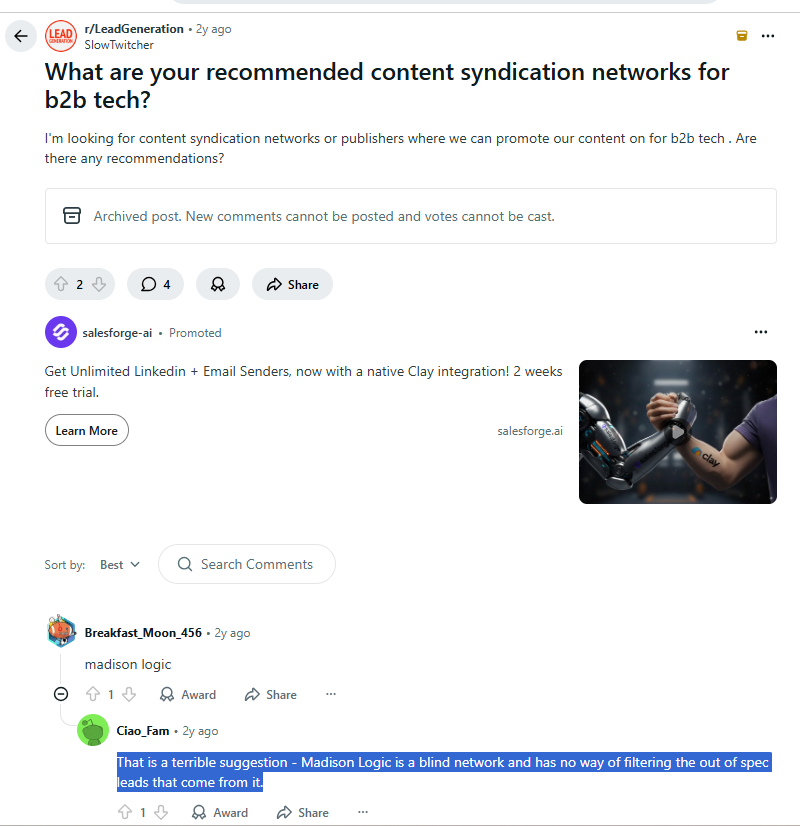
ABM Display & Social Ads
The platform can run programmatic display advertising targeted by account, as well as LinkedIn ads targeted to your account list.
Madison Logic is a LinkedIn Marketing Partner, integrating so you can use your Madison Logic account lists to hit prospects on LinkedIn as part of a coordinated campaign.
The idea is to maintain cross-channel account engagement, showing a unified presence via display banners, social ads, etc., to all members of the buying committee across their journey.
Of course, whether those display ads are effective or just wallpaper is debatable (banner blindness and bot fraud, remember?).

Connected TV & Audio Ads
In a bid to cover every channel, Madison Logic even offers targeted CTV and digital audio advertising.
This is a differentiator – few ABM platforms boast TV and radio, and it sounds cool to tell your CMO you’ve got an omnipresent campaign.
Analytics and Attribution
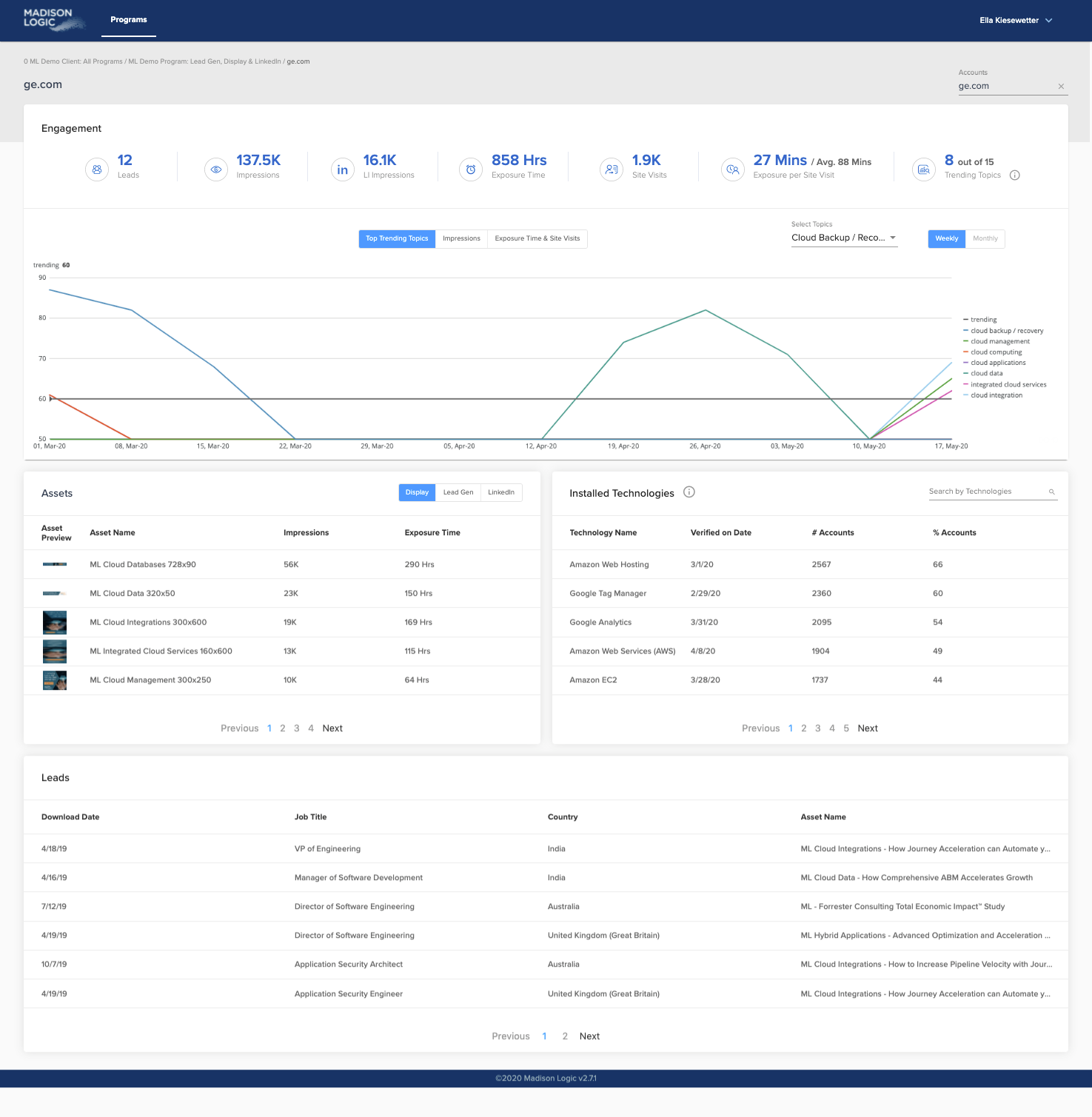
Madison Logic’s ML Measurement dashboards and the newly launched ML Intent Dashboard aim to give full visibility into how accounts are engaging and how that translates to pipeline and revenue.
The Intent Dashboard (rolled out in Nov 2025) consolidates intent signals, engagement data, and even competitive benchmarks into one view.
It can suggest “next best actions” like which hot accounts or trending topics to pursue.
Madison Logic also provide charts for account engagement, cross-channel performance, pipeline impact, and account-stage progression.

Data Sources and Targeting Capabilities
Madison Logic built its ABM edge on deep intent data expertise.
Its data arm even spun off to become Bombora in 2015.
Today, Madison Logic’s platform still draws from that legacy, combining first-party engagement signals with third-party sources like Bombora Company Surge, plus firmographic and technographic data.
Their ML Data Cloud claims to tap into two decades of behavioral data to help identify high-potential accounts.
Targeting happens across multiple channels using firmographics and job data, allowing teams to hone in on specific roles and regions, whether through content syndication, display ads, or LinkedIn.
Of course, third-party intent data based on keyword surges has its limits.
The platform can flag signals when, say, multiple people from a company read content on a topic, but that doesn’t always mean they’re ready to buy.
Some users on G2 report receiving lots of top-of-funnel leads, highlighting that data quality can vary.
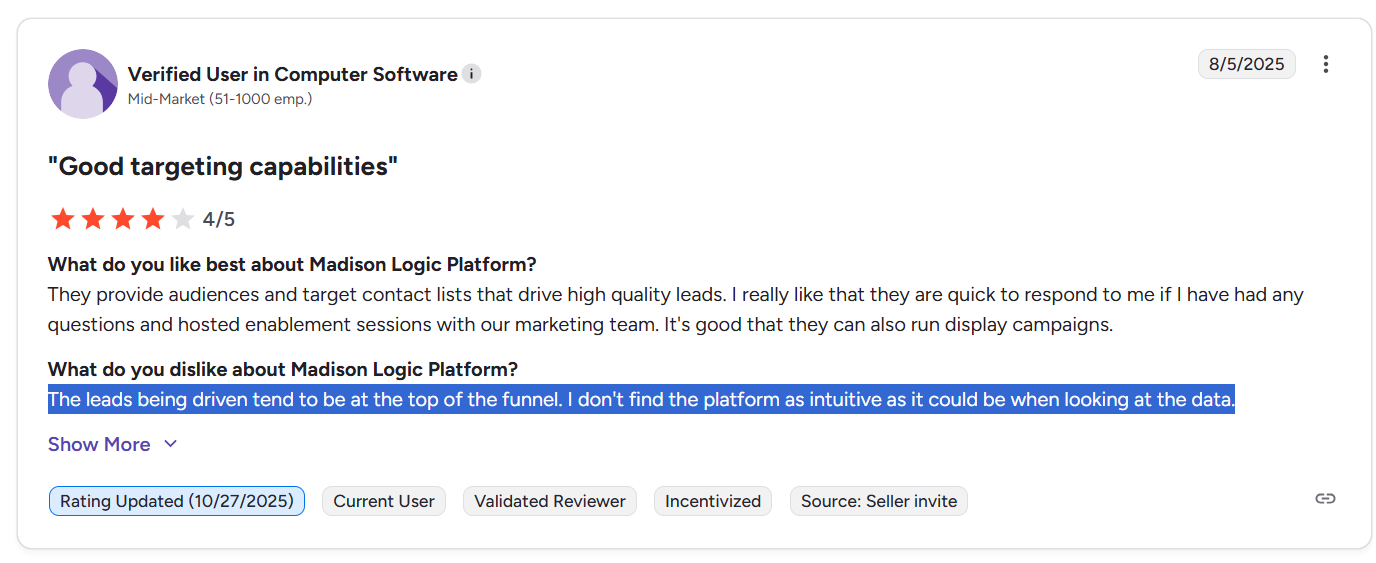
Pro Tip: ABM platforms like Madison Logic that rely on third-party keyword surge data often surface top-of-funnel leads/accounts that might be curious but aren’t truly ready to buy. This type of intent data usually costs extra and, being third-party, lacks context and precision. ZenABM takes a smarter route. It captures first-party qualitative intent by tracking how specific companies engage with your LinkedIn ads down to each ad creative. You can tag campaigns by theme (e.g. Feature A vs. Feature B), and ZenABM will group companies showing interest in each message. That means you’ll know not just who is engaging, but what they’re interested in, so your sales and follow-ups are hyper-relevant from the start.

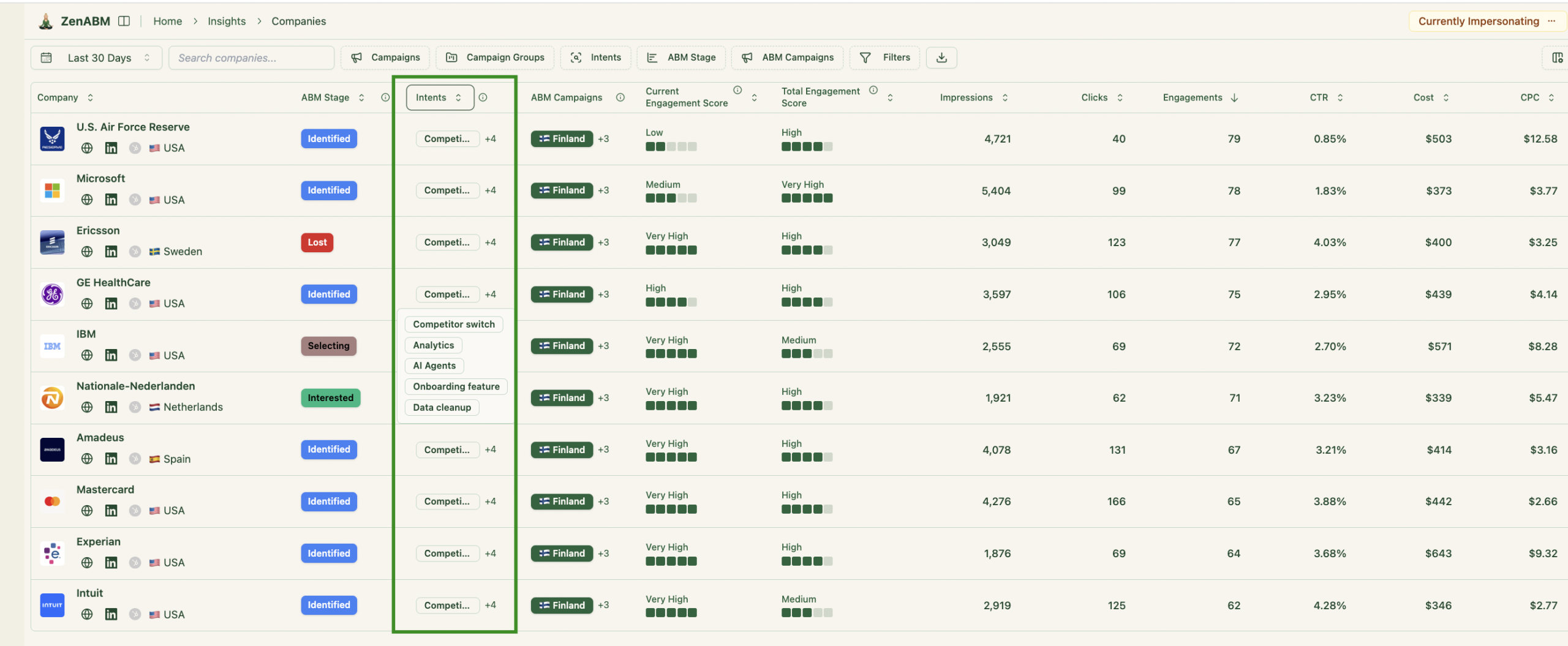
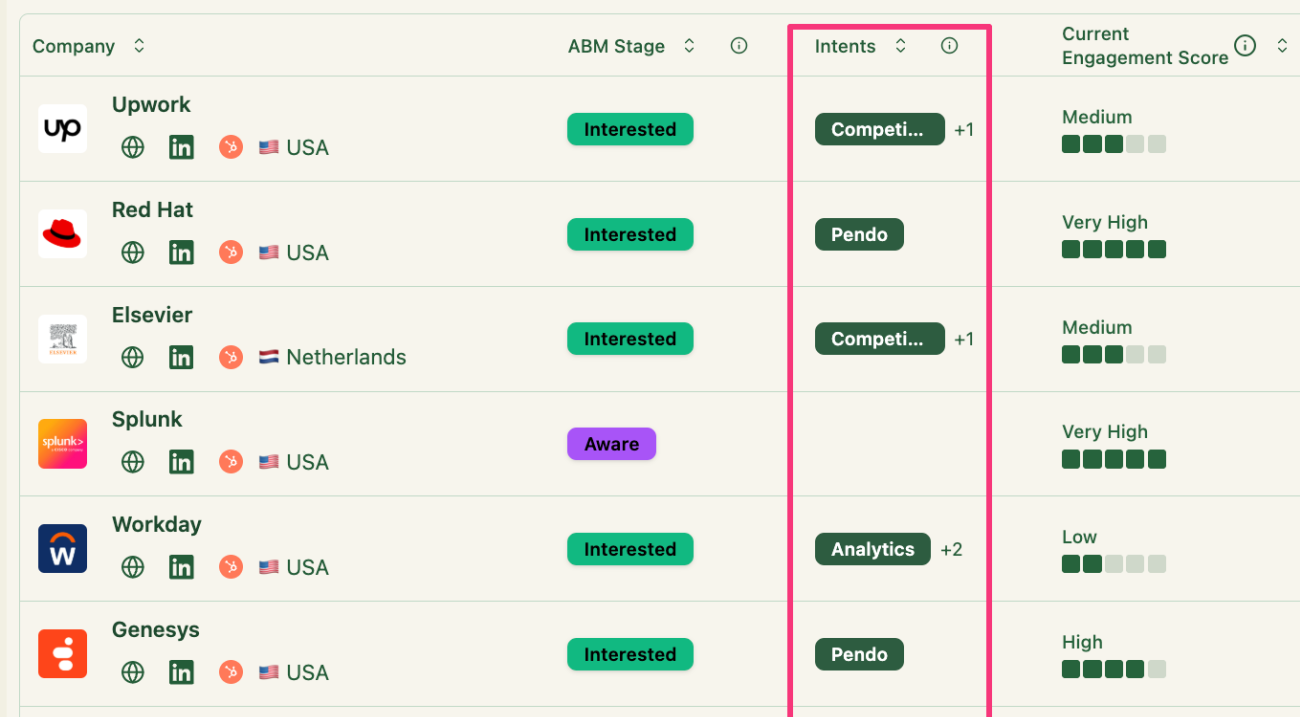
Madison Logic’s Integrations: Fitting into the Martech Stack
Madison Logic offers solid integration capabilities across major CRM, marketing automation, and sales enablement tools, making it a fit for complex B2B stacks, though setup and flexibility vary by use case.
| Platform | Integration Details | User Notes |
|---|---|---|
| Salesforce (CRM) | Embeds account insights and engagement data; ties campaigns to pipeline. | “The integration with Salesforce is everything when it comes to our reporting.” |
| HubSpot, Marketo, Pardot (MAP) | Pushes leads and engagement data into nurture streams; CRM sync. | Some users reported initial setup hiccups and fallback to CSV imports. |
| LinkedIn Marketing Solutions | Exports account segments directly into Campaign Manager for activation. | Saves time and sync costs. “Streamlines the activation process.” |
| Gong | Feeds insights into call scripts and follow-ups based on intent data. | Used to personalize sales engagement via AI-driven cues. |
| Convertr | Enriches leads in real time with intent scores and topics of interest. | Helps route qualified leads faster to the right workflows. |
| Adobe Experience Platform | Feeds intent data into Adobe’s orchestration tools (e.g. Journey Optimizer). | Enterprise-level support for full-funnel personalization. |
Madison Logic Pricing: How Much Does It Cost?
One thing conspicuously missing from Madison Logic’s website is pricing information, never a comforting sign for budget-conscious teams.
In vendor-speak, that often translates to enterprise pricing: custom deals only, probably expensive.
However, I’ve dug up some clues:
- A HubSpot Marketplace listing for Madison Logic’s integration indicated a “Professional” plan at $3,000 per month (with media costs on top). It explicitly mentions pricing as “$3,000/mo – CPM/CPL based on volume,” suggesting $3k is just the platform fee, and you pay additionally for the actual campaign reach or leads. This was last updated in 2020, so by 2025, it could be higher (or have additional tiers like Enterprise).
- Salesforce’s AppExchange lists Madison Logic with “Starting at $1 USD/company/month.” That might sound cheap, but do the math: if you want to target 5,000 accounts, that’s $5,000/month. Want 50,000 accounts in your ABM list? $50k/month. 😬 It’s an indicative metric rather than a real price sheet, but it hints that pricing scales with the number of target accounts and gets hefty for big programs.
- What about ROI? Madison Logic proudly shares a Forrester Consulting “Total Economic Impact” study claiming customers see 507% ROI over three years and payback in <6 months (take such sponsored studies with a grain of salt, but it’s part of their pitch: invest big, get bigger returns).
Note: Considering that Madison Logic comes with premium pricing, ZenABM appears to be a smarter alternative, starting at ~$59/month for a starter plan and its highest tier also doesn’t exceed $6k/year. Plus, you get all you need for LinkedIn ABM: account-level ad engagement tracking, account scoring, ABM stage tracking, assignment of hot accounts to BDRs, bi-directional CRM sync, custom webhooks, qualitative company buyer’s intent tracking, job-title-level ad engagement tracking, and plug-and-play ROI attribution dashboards.
User Impressions and Reviews
Marketing copy aside, what do actual users say about Madison Logic?
I scoured G2, TrustRadius, Reddit, and more to surface the common praise and pain points.
Pros:
- Effective Multi-Channel ABM: Many users agree that Madison Logic delivers on the promise of reaching target accounts across channels. “We’re hitting our target accounts everywhere they are,” said one G2 reviewer happily, who noted the ability to orchestrate campaigns from content syndication to display to CTV.
 Others appreciated the consolidated approach: “It addresses fragmented data and inefficient targeting by unifying ABM insights, intent data, and performance analytics in one place,” enabling coordinated campaigns.
Others appreciated the consolidated approach: “It addresses fragmented data and inefficient targeting by unifying ABM insights, intent data, and performance analytics in one place,” enabling coordinated campaigns. - Quality Lead Generation: Madison Logic’s content syndication gets high marks for producing a volume of leads that match specified criteria. A TrustRadius review stated, “lead quality is especially good… team adheres to strict requirements and will swap out stale leads.”

- Other pros claimed by reviewers include good customer support and valuable insights, which have earned Madison Logic an overall rating of 4.3 on G2 based on 241 reviews.

Cons:
- Steep Learning Curve & UI Issues: A recurring theme is that Madison Logic is powerful but complex. “It’s a powerful platform, and the learning curve can be a bit steep initially,” said a G2 reviewer. New users or those not well-versed in ABM might struggle. Another noted that the navigation can be confusing with similarly named modules. The UI could be more intuitive; one user bluntly said, “I don’t find the platform as intuitive as it could be when looking at the data.” The consensus: expect a ramp-up period and rely on training from the Madison Logic team to fully grasp all features.

- Integration Hiccups: Despite strong integration capabilities, a few users reported technical snags connecting to their systems. Instances of lead sync failures requiring manual CSV export were mentioned. The HubSpot integration, taking “a little while” to get working, popped up in a review (though resolved with support help). And as noted earlier, companies with multiple org units found they couldn’t use one ML instance for all due to billing separation.
- Top-of-Funnel Emphasis: Some customers looking for bottom-of-funnel impact felt Madison Logic skews early-stage. “The leads being driven tend to be at the top of the funnel,” one reviewer observed, adding that they wished the platform facilitated more intuitive analysis of data deeper in the funnel.
- Cost and Scale for Smaller Users: While not often directly mentioned (perhaps because smaller companies are less likely to be using Madison Logic and writing reviews), there’s an inferred critique that Madison Logic is better suited to large enterprises. In Reddit threads, some folks recommend Madison Logic for content syndication, while others immediately dismiss it as overkill or outdated for modern agile teams. One Redditor flatly called it “a terrible suggestion” for a content syndication network.

- Miscellaneous: A unique complaint from one user was that the platform couldn’t handle multiple billing entities, requiring separate instances per region or division.
ZenABM: A Lean First-Party LinkedIn ABM Alternative
One alternative to Madison Logic is ZenABM.
It is specifically designed for LinkedIn ABM, so it can either be a complete, lean and affordable alternative to Madison Logic for teams that mainly advertise on LinkedIn.
Even for teams running multi-channel ABM, ZenABM can be a complementary layer to Madison Logic or whichever bigger ABM suite they are using because of ZenABM’s unique features.
Let’s look at those features:
LinkedIn Ads Engagement at the Account Level


ZenABM integrates directly with the LinkedIn Ads API to pull account-specific data from all campaigns.
This allows you to identify precisely which target accounts are interacting with your LinkedIn ads (impressions, clicks, etc.), all mapped to individual companies.
Pro Tip: ZenABM can also reveal anonymous website visitors for free. Retarget them with inexpensive LinkedIn text ads, and ZenABM will identify the companies that saw your impressions.
Real-Time Engagement Scoring

ZenABM continuously updates engagement scores from ad interactions. You can monitor recent trends (like the past week) or historical patterns to identify accounts heating up.
These scores help marketing and sales prioritize high-value accounts for follow-up.
ABM Stage Tracking

ZenABM enables you to define your ABM funnel stages (e.g., Identified → Aware → Engaged → Interested → Opportunity) and automatically classifies accounts using engagement and CRM information.
You can set your own thresholds for “Engaged” or “Interested,” and ZenABM will track stage transitions automatically.
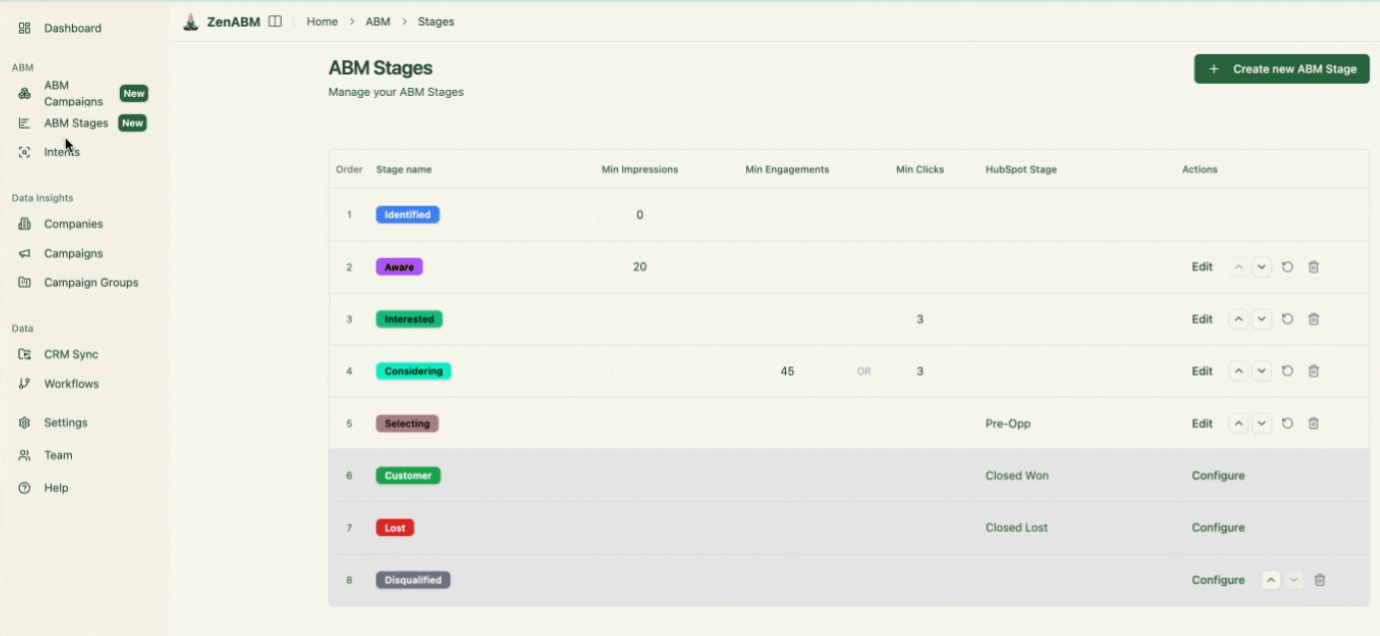

This delivers full-funnel visibility like enterprise ABM platforms, highlighting where accounts stall and where progress accelerates.
CRM Integration and Workflows
ZenABM integrates bidirectionally with CRMs such as HubSpot (Salesforce available on higher plans).
LinkedIn engagement data feeds directly into your CRM as company-level properties, keeping sales teams informed:
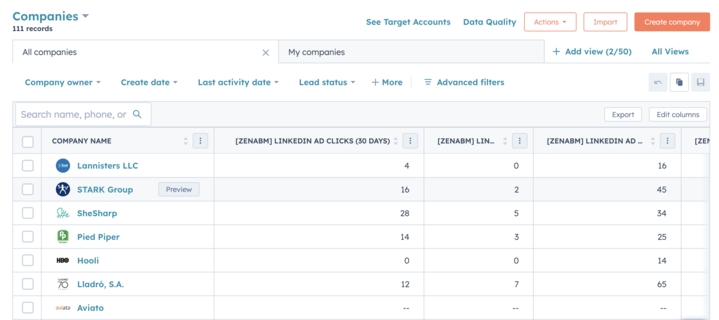
ZenABM can auto-update account stages to “Interested” when engagement passes a set threshold and assign accounts to specific BDRs for follow-up.

Intent Tagging from LinkedIn Ads Engagement
ZenABM allows you to tag campaigns by theme (like “Feature A” vs. “Feature B”) and shows which accounts engage with which themes, revealing their priorities.
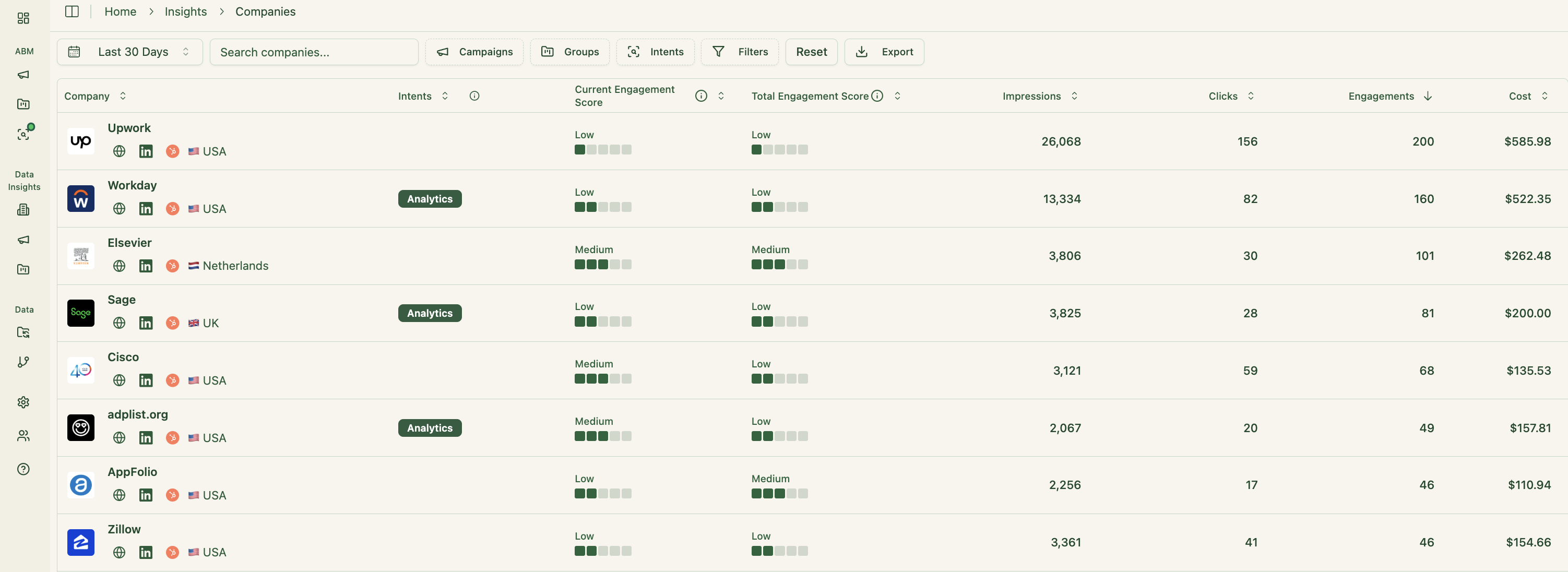
This is genuine first-party intent. Instead of paying for inferred keyword interest, you get direct proof like Account Z clicking “Feature A” ads, demonstrating actual buying interest.
These insights also sync to your CRM, supporting highly targeted outreach and relevant messaging.
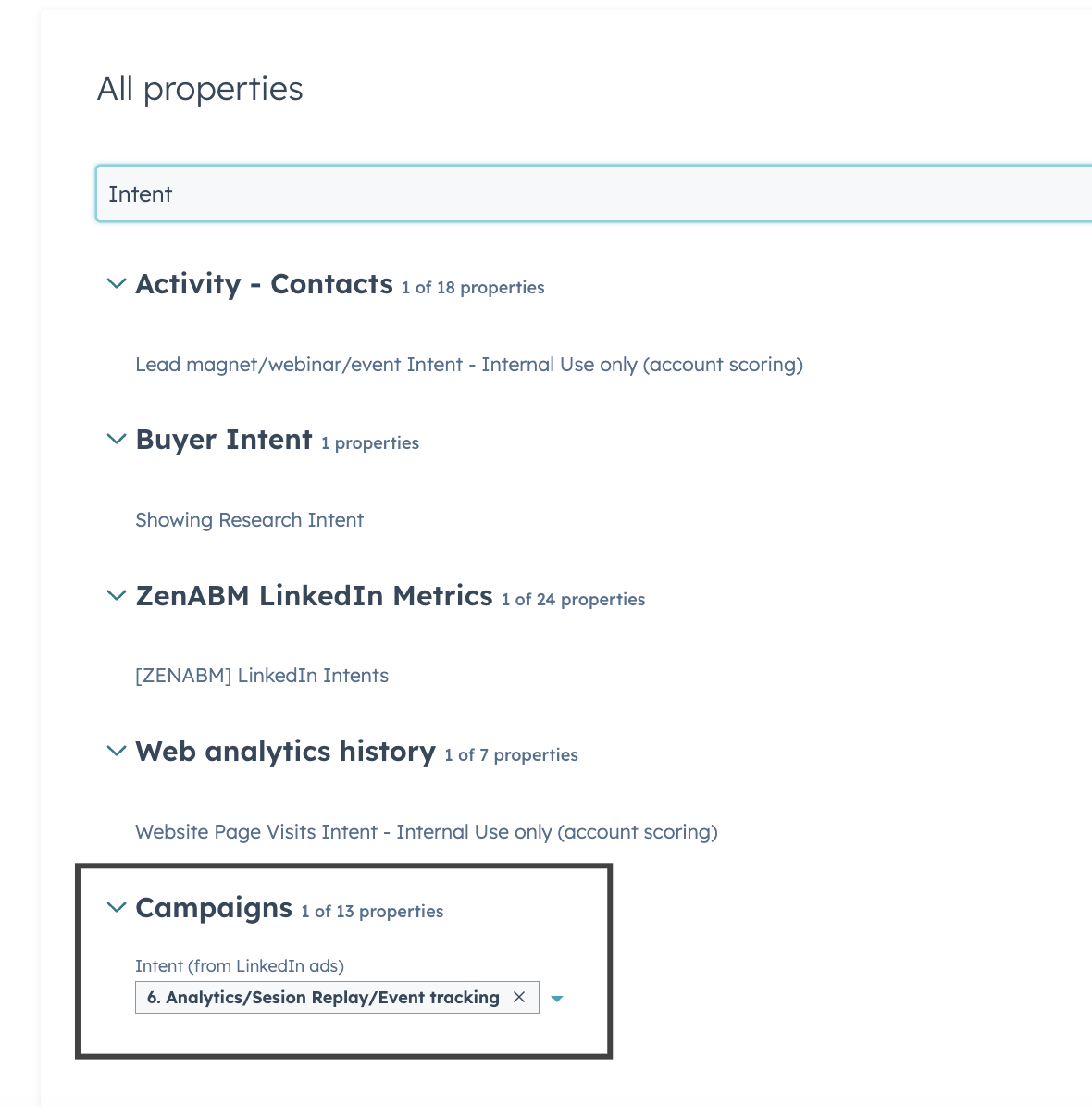
Your sales reps can instantly see which topics or pain points each account reacts to most.
This feature is fairly unique to ZenABM, making it a worthwhile add-on even if you already have an existing subscription to some other ABM tool.
Job-Title Analytics
ZenABM also gives a breakdown of the specific job titles that interact with your ads.
Raw metrics, dwell time, full video funnel – all available out of the box.
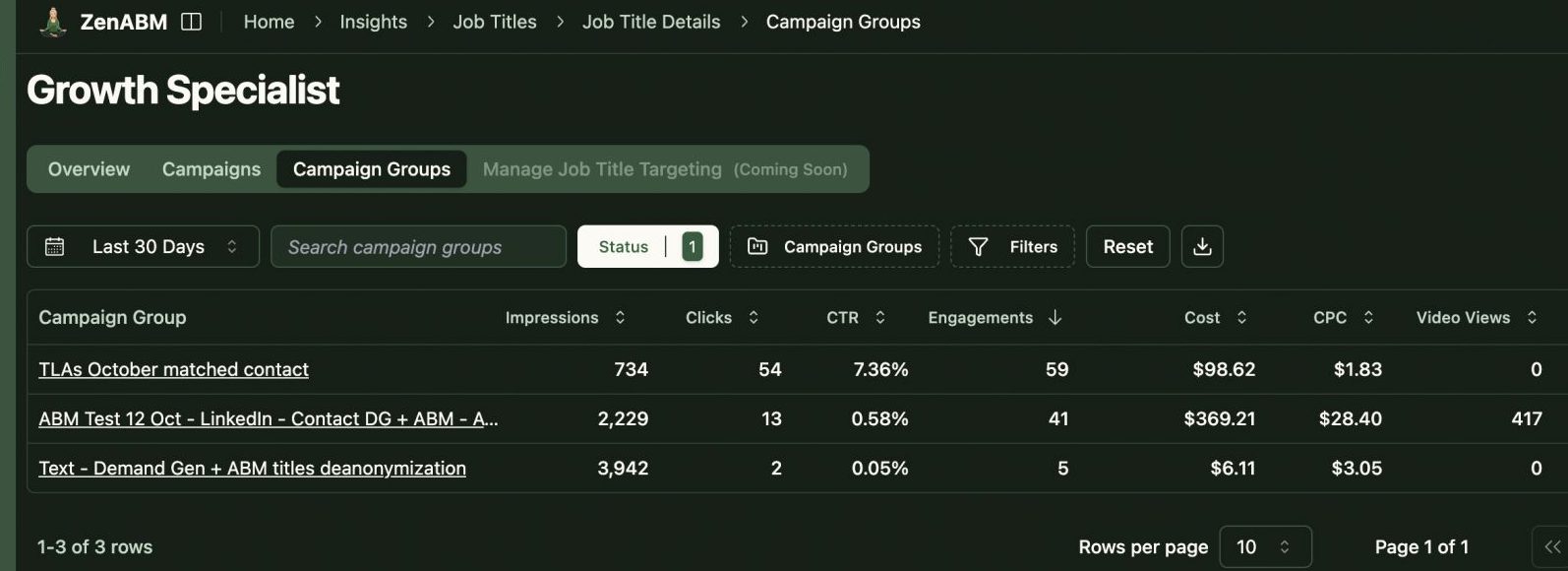
Built-in Dashboards and ABM Analytics
ZenABM includes pre-built ABM dashboards linking ad exposure, engagement, funnel stages, and pipeline metrics.
- Track performance across campaigns, LinkedIn groups, and individual ads:
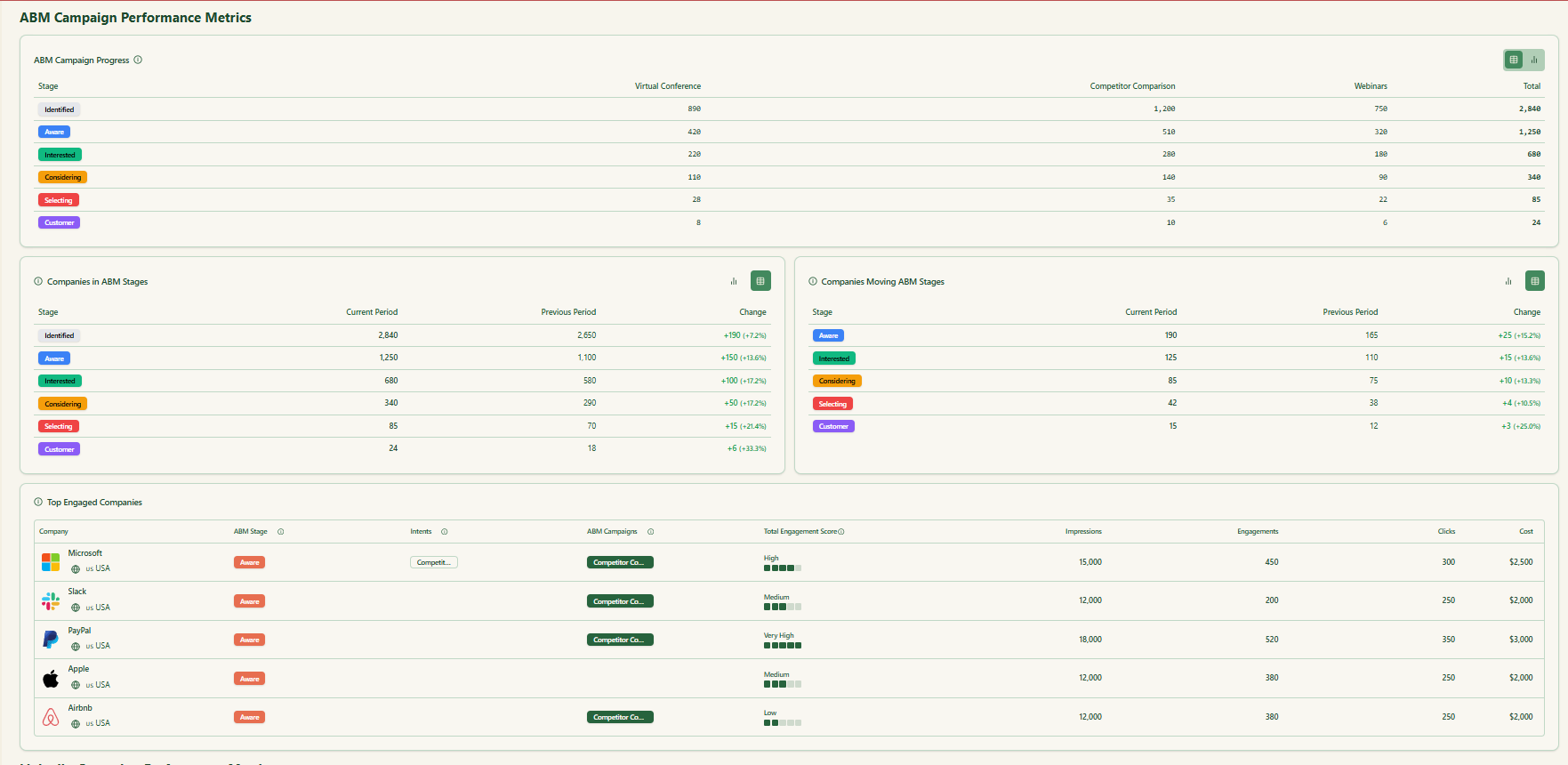

- ZenABM tracks both deal size and ad spend per account/campaign, enabling ROAS, pipeline per dollar, and campaign-driven revenue insights. Revenue teams can use this to optimize engagement and accelerate deal closure rather than focusing on vanity metrics

Custom Webhooks
With the newly rolled out custom webhooks, ZenABM can fit into any of your workflows as needed.
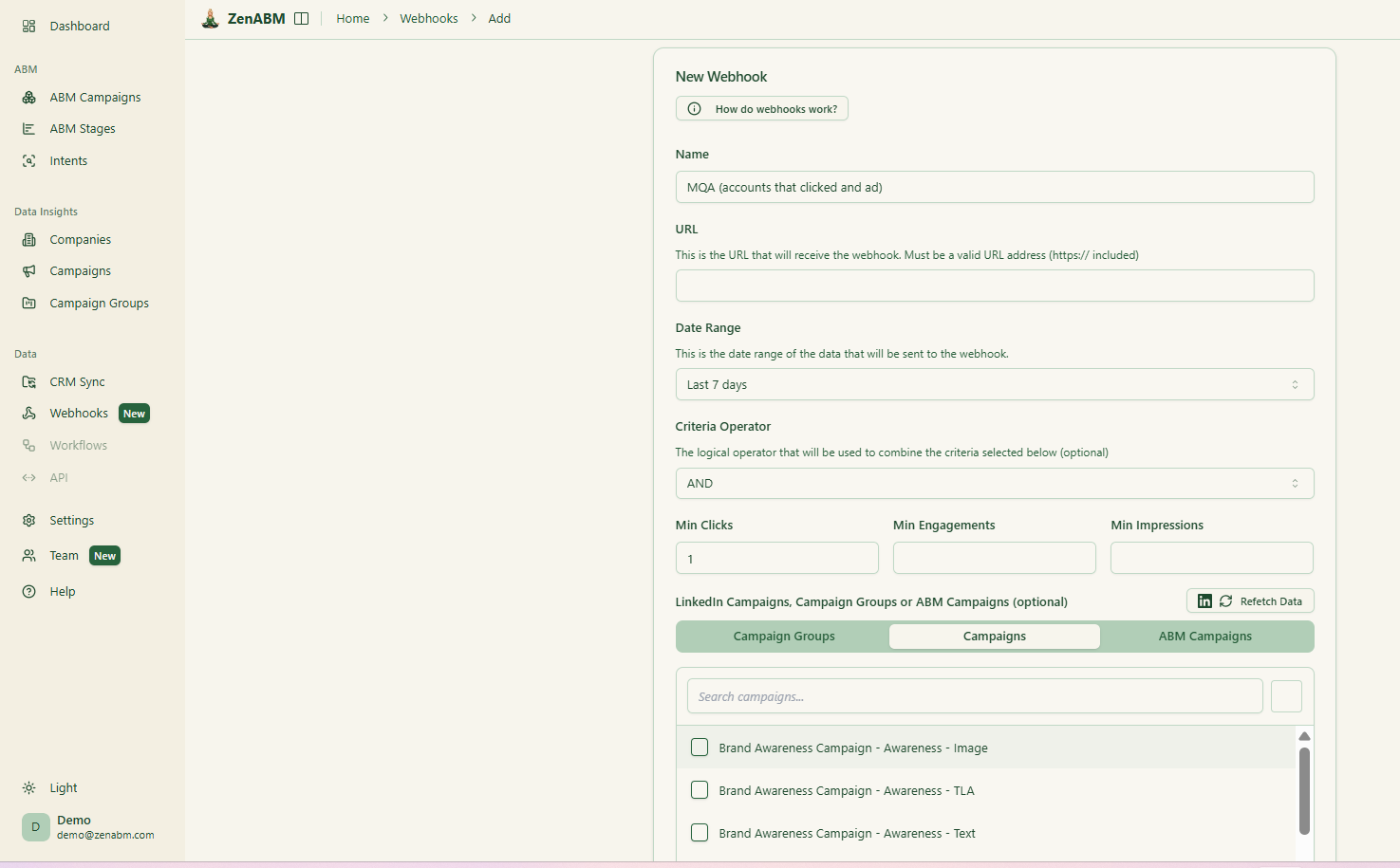
ZenABM Pricing
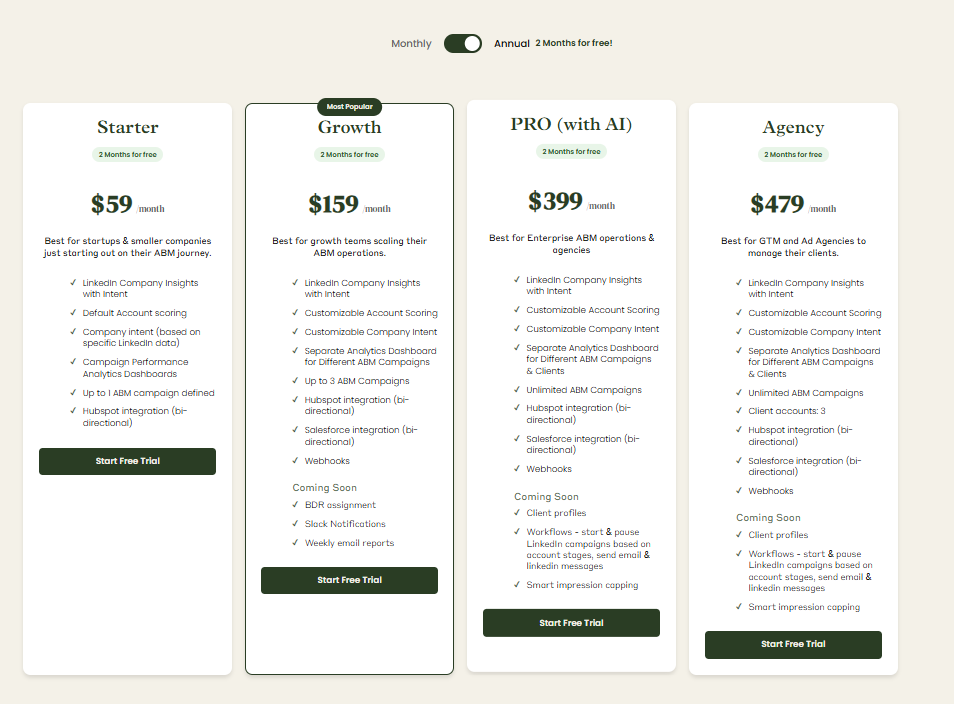
Plans start at $59/month for Starter, $159/month for Growth, $399/month for the Pro (AI) tier, and $479/month for the agency tier.
Even the highest tier costs under $6,000/year, far less than Madsion Logic.
All plans cover essential LinkedIn ABM functions, with higher tiers mostly expanding limits or adding Salesforce integration.
Pricing is flexible (monthly or annual with two months free), and a 37-day free trial allows teams to try before buying.
Conclusion
Madison Logic offers robust enterprise-grade ABM capabilities across channels, backed by decades of third-party intent data.
But its complexity, high cost, and reliance on top-of-funnel signals may not suit every team.
For marketers focused on LinkedIn ABM or looking for faster, leaner execution with first-party qualitative insights, ZenABM presents a high-impact alternative or complementary layer.
With deep LinkedIn ad engagement analytics, CRM integration, and flexible pricing, it’s built for modern, insight-driven B2B teams.
Whether you’re starting your ABM journey or looking to fill gaps in your current stack, it’s worth exploring ZenABM’s 37-day free trial.



